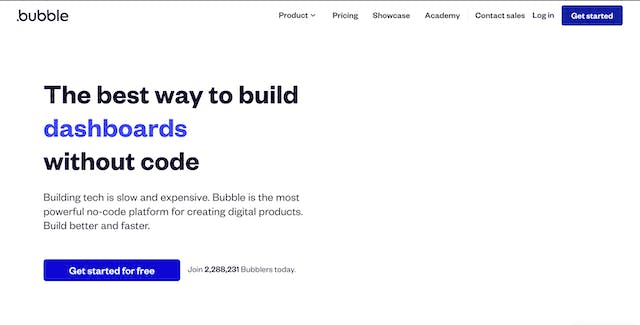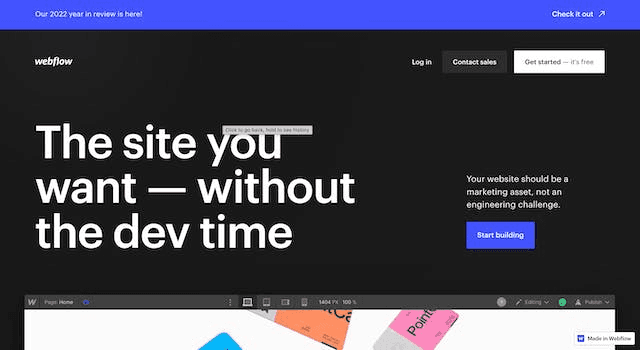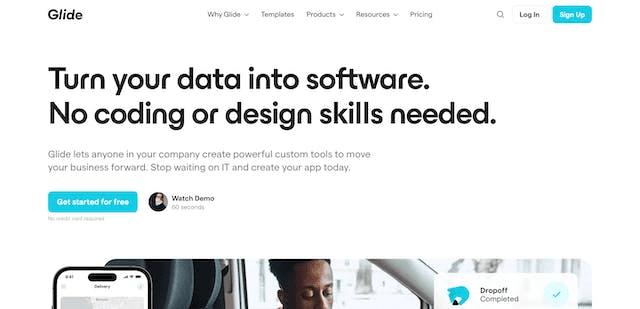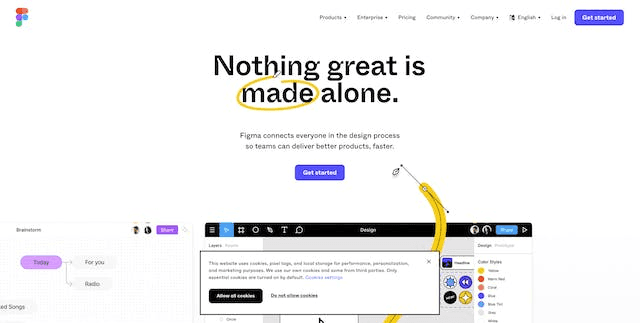Nowadays, all businesses around the world have to find creative ways of adapting to an increasingly challenging economic climate. That’s why it’s no surprise that demand for software creation has reached a historical peak. Companies are hiring developers now more than ever.
The thing is, there is far more demand than developers can cope with. Creating an app with traditional software development can also get extraordinarily expensive and time-consuming – something most businesses in the world won’t necessarily be able to afford.
Hence why in recent years, the no code movement has gained so much traction. The goal is for non-programmers to be able to create software without having to write a single line of code. A world where anyone, regardless of their financial means or capabilities can build apps sounds pretty powerful, right?
Chris Wanstrath, CEO of GitHub, claimed that “the future of coding is no coding at all”. GitHub is a platform of over 50 million developers, so Chris’s opinion is pretty serious. But just how can the no-code movement help SMEs grow and scale in 2023? Is it really as exciting as it sounds?
SMEs, small or medium-sized enterprises, are a huge part of our economy here in the UK. In fact, they make up 99% of the business landscape. Let’s explore what no-code can do for your small/medium-sized business and how you can make the most of it all. 👇
What is No Code?
No-code platforms allow users to create apps, software and websites without having to write code. The no code approach therefore requires very little to no knowledge of programming in order to build an app. This means that those who have extensive knowledge of their field can create potent software and websites, tailored specifically to their industry.
How is this possible, you ask? Well, no code platforms employ a visual approach to programming, whereby logic is used to manipulate code. That means that you can use visual elements often in the form of drag-and-drop builders to create apps and websites.
In a certain sense, no-code doesn’t mean there is no coding involved, it just means you won’t ever have to deal with it – it’s all behind the scenes. If you’re really interested in how it works, feel free to read up on data abstraction and encapsulation, which is what these code platforms such as Bubble, Webflow and Glide use to hide the complex code that is being utilised.
So, what does being able to create apps and websites without actually having to write code mean for your business? What are the benefits of no code for SMEs?
The Benefits of No Code for SMEs
If you run a business, you’ll know that introducing new tools to your team can be a challenge. First, you need to spend what feels like a lifetime researching your options and considering whether you’ve got the necessary resources in terms of budget, etc. Then you’ll still need to train your team and continually monitor whether the new software is performing well.
We can’t blame you for being hesitant when it comes to implementing new software. But with no code, the days of outdated software are over. No code tools can make an immense difference for your team. In most cases, no code will be substantially more affordable than traditional software, and so much more accessible too. Let’s find out more about the full set of benefits of no code for SMEs.

1. Speed and time to market
A recent survey found that no-code is known to be 40 to 50% faster than traditional software development. A traditional app commonly takes 4 to 9 months to get to an initial workable version and several months more for a completely finished product.
Most no-code platforms, however, only require a few weeks from start to finish to build fully complete apps and websites. That is why the main benefit of no-code development is rapid deployment.
No-code can significantly reduce time to market, allowing you to easily meet customer demand. Design and development are performed simultaneously with no-code, resulting in a seamless and fast process.
However, it is important to note that if the time to market is your priority, you might want to consider outsourcing your no-code project. By outsourcing the build of your software or website, you’ll be getting to the finished product a lot quicker than without. You’ll also be able to:
Build the right solution from day 1 and be confident in the time and money you’re investing
Focus on running usual operations
Create strong foundations that won’t disappoint you down the line
Not disrupt your team’s daily tasks
Easily implement changes according to feedback
✅ Check out our list of approved agencies you can outsource your no-code project to. You can also outsource your project to developers certified by different no-code platforms – this is our list of Bubble developers and Figma designers to bring your idea to life.
2. Agility – effortless to update
When you build an app or a website with no-code, you’re not relying on a whole team of developers to write unintelligible lines of code until they get your project right. Every single stage from planning and wireframing to MVP and deployment keeps costs and time under control because it doesn’t take an army of programmers.
SMEs usually don’t have the luxury of promptly creating solutions for every single challenge they come across. Because no-code platforms offer so much flexibility, you’ll be able to make extremely quick changes and respond to any kind of demand that comes your way. Requirements change constantly, so it’s reassuring to know you can be agile and react quickly.
What’s more, the no-code movement empowers its users to solve problems by building custom solutions without any kind of technical training. Whether these solutions are internal tools or extensions of your core offering, you’ll be able to leverage agility across your whole organisation.
3. Flexibility and customisation
No-code solutions are extremely customisable. Whatever you’re building, no code platforms will help you scale your operation, from workflow automation to website launching or customer engagement. You’ll be able to customise pretty much anything. You’re essentially building a solution from the ground up, so you can expect to be able to create entirely custom apps and websites with no-code.
Not only is no-code customisable but it is also truly versatile stemming from the fact that it is open source. Once you start building, you won’t be trapped by a specific architecture, you’ll just be able to keep coming up with efficient solutions to grow your business.
In that sense, no-code is anti-commitment. As an SME, you won’t want to have to commit permanently to a solution that might now grow with your ever-changing needs. Most no code platforms allow data to be easily imported and exported to move from one solution to another without affecting operations.
In contrast, if you were creating solutions with traditional development, migrating from one architecture to another would be an absolute nightmare. With no code you can implement instant changes with the click of a button.
4. Cost savings
Traditional software development can be insanely expensive. In fact, having a solution programmed from start to finish can cost anywhere between $35,000 and $180,000! That’s not something most of us can afford in these tough economic times, between the hiring freezes and the increasing requirement to be cost-efficient. Faced with supply chain issues around the world, businesses just don’t have the resources to invest thousands into solutions that take months and large teams of developers to build.
No-code, on the other hand, will allow you to create impressively custom solutions without spending a fortune. Here at Goodspeed, for example, we typically charge around $5-15K per project. That means that it will cost you a fraction of the price of traditional development for a no code app/website, from ideation to iteration.
By the way, a lot of no-code tools offer a free trial, and some will even let you build for free until your project is ready to go. That’s hugely different from having to invest thousands in developer salaries before you can see the first workable version of your project…
5. Improved productivity
Using automation to help with productivity isn’t new, it’s been around for a while. When you implement no-code tools into your workflow, you’re opening the door to substantially increased productivity. You’ll be able to relieve your team of all the repetitive tasks they’re wasting their time on so that they can focus on what will help the business scale.
Another important aspect of productivity is being able to easily handle data. We’ve all had to deal with hectic Excel spreadsheets that make it impossible to find information. By leveraging no code tools for data handling, you can easily organise, list, track, and manage the information that is so crucial to your business.
6. The ability to solve specific pain points
SMEs have pretty specific needs that no code’s repeatable functions can easily target. This means that whichever challenge arises in the complicated current customer landscape we’re navigating through, you’ll be able to solve the pain point through no-code.
For example, customers seem to have higher expectations than ever in such a connected world. They won’t settle for less than fast and seamless digital experiences from the brands they consume. No code will let you effortlessly digitise your customer experience all the way down the pipeline – you’ll end up with happy customers that come with lots of loyalty and retention.
7. Improved communication
By leveraging no-code solutions, you’ll be able to utilise several channels for better communication in general. Whether that means providing intuitive customer feedback options, improving customer service with in-app chats for example, or building an interactive knowledge base to answer customers’ questions even before they come up – no code can do amazing things to improve communication for your SME.
This goes beyond customer satisfaction though. Because it’s so easy to iterate changes with no code platforms, you’ll be able to collect feedback externally on multiple occasions and respond to issues immediately after having run user tests. You can then effortlessly publish an infinite amount of different versions. This gives a powerful platform for your team to collaborate efficiently.
You’ll also find that most no-code platforms offer seamless methods of communication so that you can easily collaborate on projects. No more email flooding and impossibly long chains, you’ll be able to interact with your team within your no-code platform of choice as you’re building projects.

The Top 4 No-Code Tools
Hopefully, by now, you’ll have got the impression that no code is full of promise for your SME. But you might now be wondering what tool to go for exactly.
Check out our list of the 4 best no-code tools out there. Want to see more? Here is our complete list of every single no-code platform! 🔥
1. Bubble

We had no choice but to place Bubble at the very top of this list. It’s a favourite among many no code enthusiasts because of its boundless options for customisation. Bubble is a powerful platform that will make building your next app, website, dashboard, inventory manager or directory (and many more) a walk in the park. You can even integrate AI tools, it's a leader in the no-code and AI space.
Bubble’s Pricing
Free Personal Professional Production
$0 per month $25 per month $115 per month $475 per month
2. Webflow

Webflow is another favourite of ours, though slightly less powerful than Bubble and much more geared towards creating websites rather than complex software. Webflow has an intuitive drag-and-drop interface and plenty of gorgeous templates to choose from. We really love the fact that it also offers some powerful marketing features like SEO and content management.
By the way, if you’re wondering if Webflow is better than Bubble, check out our guide to Webflow vs Bubble.
Webflow’s Pricing
Starter Basic CMS Business
$0 per month $14 per month $23 per month $39 per month
3. Glide

Glide’s selling point was initially that it allowed users to go from spreadsheet to app in minutes. This is now slightly obsolete because you can now build Glide apps without having to use spreadsheets as your data source. Nevertheless, the promise is pretty enticing. Who doesn’t want to get rid of all those haunting spreadsheets?
Glide’s Pricing
Free Pro Business Enterprise
$0 per month $99 per month $249 per month $779 per month
4. Figma

Figma is a browser-based UI and UX design platform that has often been coined as the best collaborative design tool out there. The platform allows users to prototype any kind of design project and then export the design into code. That means that you can easily create designs for apps for example and then plug the code into another no code tool.
Figma’s Pricing
Free Professional Organisation
$0 per month $11 per month $37 per month
Takeaway: No-Code & SMEs
It has recently been found that 85% of consumers prefer using apps over mobile websites. Whether it’s because of our current attention economy, because apps are considered to be overall more convenient to use, or because consumers simply want the highest level of modernisation – expectations have changed.
This fast paced environment can sometimes be difficult for SMEs to adapt to because traditionally, creating new software and digital products for changing demands meant spending a lot of time and money.
Nowadays though, with the advent of no-code, creating an app can mean spending a few hours dragging and dropping visual elements on an interface, without writing any code whatsoever.
Leveraging no-code for your SME can bring many different benefits, including:
The ability to be agile and adapt to changes
Increased production and communication among your team
Providing higher quality customer experiences
The opportunity to rapidly create solutions to answer customer demands
The option of solving specific pain points as they come
Interested in getting your own no-code solution for your SME? We can help. Here at Goodspeed, we’re passionate about sharing the boundless possibilities that no code offers. We’ll build your no-code project for you so that you can focus on running things.
📞 Book a call with us today to get started. Effortlessly scaling your business with no-code for a fraction of the cost of development is only a few clicks away…
Want to find out more about no-code? Check out our 2023 predictions for the no-code space.

Conclusion
Harish Malhi
Founder of Goodspeed
Harish Malhi is the founder of Goodspeed, one of the top-rated Bubble agencies globally and winner of Bubble’s Agency of the Year award in 2024. He left Google to launch his first app, Diaspo, built entirely on Bubble, which gained press coverage from the BBC, ITV and more. Since then, he has helped ship over 200 products using Bubble, Framer, n8n and more - from internal tools to full-scale SaaS platforms. Harish now leads a team that helps founders and operators replace clunky workflows with fast, flexible software without writing a line of code.
Frequently Asked Questions (FAQs)
What is no code and how does it work for SMEs?
No code refers to platforms that enable users to create software, apps, and websites without needing to write code. For SMEs, this means that individuals without coding knowledge can build tailored solutions using visual elements like drag-and-drop builders. No code platforms use logic to manipulate code behind the scenes, allowing users to create powerful software specific to their industry.
What are the benefits of using no code for SMEs?
No code offers several benefits for SMEs: Speed and Time to Market - development is 40-50% faster than traditional coding; Agility - allows for quick and flexible updates; Flexibility and Customization - highly customizable solutions that grow with business needs; Cost Savings - more cost-effective than traditional development; and Improved Productivity - automation features reduce repetitive tasks and streamline workflows.
How does no code help SMEs overcome specific pain points?
No code's flexibility and adaptability make it ideal for addressing SMEs' unique challenges. Whether it's digitizing customer experiences, creating internal tools, or building extensions for core offerings, no code allows SMEs to create custom solutions for their pain points.
How does no code improve communication and collaboration for SMEs?
No code platforms offer various communication channels, including customer feedback options, in-app chats, and interactive knowledge bases. Teams can collaborate efficiently within the platform, collect feedback, and iterate changes easily. This results in improved communication both internally and externally.
Which are some of the top no code tools recommended for SMEs?
Some of the top no code tools include: Bubble - known for its customization options and integration with AI tools; Webflow - offers intuitive website building with SEO and content management features; Glide - allows users to build apps from spreadsheets quickly; and Figma - a UI/UX design platform that can export designs into code for other no code tools.
How can SMEs leverage no code to provide higher quality customer experiences?
No code platforms enable SMEs to digitize customer experiences easily. With seamless development and iterative changes, you can create apps and solutions that meet customer expectations for fast and seamless digital interactions. This can lead to improved customer satisfaction, loyalty, and retention.
How long does it take to build an app with no code compared to traditional development?
Traditional app development commonly takes 4 to 9 months to reach an initial workable version and several months more for a completely finished product. Most no-code platforms, however, only require a few weeks from start to finish to build fully complete apps and websites, making no-code development 40 to 50% faster than traditional software development.









